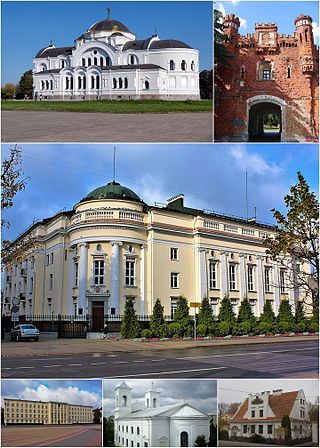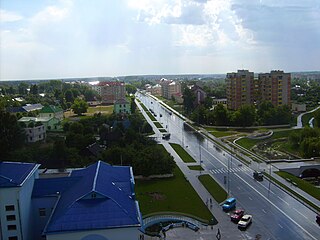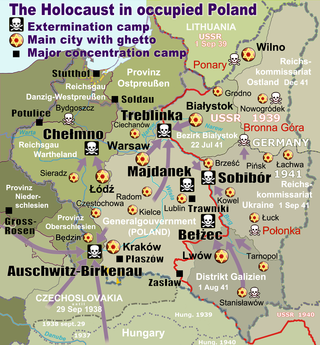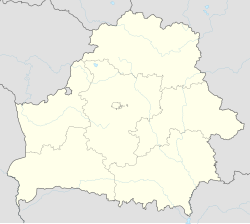
The Final Solution or the Final Solution to the Jewish Question was a Nazi plan for the genocide of individuals they defined as Jews during World War II. The "Final Solution to the Jewish question" was the official code name for the murder of all Jews within reach, which was not restricted to the European continent. This policy of deliberate and systematic genocide starting across German-occupied Europe was formulated in procedural and geopolitical terms by Nazi leadership in January 1942 at the Wannsee Conference held near Berlin, and culminated in the Holocaust, which saw the murder of 90% of Polish Jews, and two-thirds of the Jewish population of Europe.

Brest, formerly Brest-Litovsk and Brest-on-the-Bug, is a city in Belarus at the border with Poland opposite the Polish town of Terespol, where the Bug and Mukhavets rivers meet, making it a border town. It serves as the administrative center of Brest Region and Brest District, though it is administratively separated from the district. As of 2024, it has a population of 344,470.

Pinsk is a city in Brest Region, Belarus. It serves as the administrative center of Pinsk District, though it is administratively separated from the district. It is located in the historical region of Polesia, at the confluence of the Pina River and the Pripyat River. The region was known as the Pinsk Marshes and is southwest of Minsk. As of 2024, it has a population of 124,295.

Kobryn or Kobrin, is a town in Brest Region, Belarus. It serves as the administrative center of Kobryn District. It is located in the southwestern corner of Belarus, where the Mukhavets river and Dnieper–Bug Canal meet. The town lies about 52 kilometres (32 mi) east of the city of Brest. As of 2024, it has a population of 52,635.

Ivatsevichy is a town in Brest Region, Belarus. It serves as the administrative center of Ivatsevichy District. As of 2024, it has a population of 22,377.

Drahichyn is a town in Brest Region, in south-western Belarus. It serves as the administrative center of Drahichyn District. As of 2024, it has a population of 14,804.

Lakhva is a village in Luninets District, Brest Region, Belarus. It serves as the administrative center of Lakhva selsoviet. It has a population of approximately 2,100.
Motal or Motol is an agrotown in Ivanava District, Brest Region, Belarus. It is located about 30 kilometres west of Pinsk on the Yaselda River.

Klyetsk or Kletsk is a town in Minsk Region, Belarus. It serves as the administrative center of Klyetsk District. Klyetsk is located on the Lan River. As of 2024, it has a population of 11,248.

Antopal or Antopol is an urban-type settlement in Drahichyn District, Brest Region, Belarus. It is located near the towns of Kobryn and Brest. As of 2024, it has a population of 1,428.

The Korherr Report is a 16-page document on the progress of the Holocaust in German-controlled Europe. It was delivered to Heinrich Himmler on March 23, 1943, by the chief inspector of the statistical bureau of the SS and professional statistician Dr Richard Korherr under the title die Endlösung der Judenfrage, in English the Final Solution to the Jewish Question. Commissioned by Himmler, Korherr calculated that, from 1937 to December 1942, the number of Jews in Europe had fallen by 4 million. Between October 1939 and December 31, 1942, 1,274,166 Jews had been "processed" at the camps of the General Government and 145,301 at the camps in Warthegau.

When the Second World War in Europe began, the territory which now forms the country of Belarus was divided between the Soviet Union and the Second Polish Republic. The borders of Soviet Belarus were greatly expanded in the Soviet invasion of Poland of 1939. In 1941, the country was occupied by Nazi Germany. Following the German military disasters at Stalingrad and Kursk, the collaborationist Belarusian Central Council (BCC) was formed by the Germans in order to raise local support for their anti-Soviet operations. The BCC in turn formed the twenty-thousand strong Belarusian Home Defence (BKA), active from 23 February 1944 to 28 April 1945. Assistance to collaborators was offered by the local Soviet administrative governments, and prewar public organizations including the former Soviet Belarusian Youth. The country was soon retaken by the Red Army in 1944. Devastated by the war, Belarus lost significant populations and economic resources. Many battles occurred in Belarusian territory. Belarusians also participated in the advance towards Berlin.

Polesie Voivodeship was an administrative unit of interwar Poland (1918–1939), named after the historical region of Polesia. It was created by the Council of Ministers of the Second Polish Republic on February 19, 1921, as a result of peace agreement signed with the Russian and Ukrainian SSRs in Riga. Polesie Voivodeship was the largest province of interwar Poland. It ceased to function in September 1939, following the Nazi-German and Soviet invasion of Poland in accordance with a secret protocol of the Nazi–Soviet Pact of non-aggression.

In the early modern era, European Jews were confined to ghettos and placed under strict regulations as well as restrictions in many European cities. The character of ghettos fluctuated over the centuries. In some cases, they comprised a Jewish quarter, the area of a city traditionally inhabited by Jews. In many instances, ghettos were places of terrible poverty and during periods of population growth, ghettos had narrow streets and small, crowded houses. Residents had their own justice system. Around the ghetto stood walls that, during pogroms, were closed from inside to protect the community, but from the outside during Christmas, Pesach, and Easter Week to prevent the Jews from leaving at those times.

ŁachwaGhetto was a Nazi ghetto in Łachwa, Poland during World War II. The ghetto was created with the aim of persecution and exploitation of the local Jews. The ghetto existed until September 1942. One of the first Jewish ghetto uprisings had happened there.

The Brześć Ghetto or the Ghetto in Brest on the Bug, also: Brześć nad Bugiem Ghetto, and Brest-Litovsk Ghetto was a Nazi ghetto created in occupied Western Belarus in December 1941, six months after the German troops had invaded the Soviet Union in June 1941. Less than a year after the creation of the ghetto, around October 15–18, 1942, most of approximately 20,000 Jewish inhabitants of Brest (Brześć) were murdered; over 5,000 were executed locally at the Brest Fortress on the orders of Karl Eberhard Schöngarth; the rest in the secluded forest of the Bronna Góra extermination site, sent there aboard Holocaust trains under the guise of 'resettlement'.

The Pińsk Ghetto was a Nazi ghetto created by Nazi Germany for the confinement of Jews living in the city of Pińsk, Western Belarus. Pińsk, located in eastern Poland, was occupied by the Red Army in 1939 and incorporated into the Byelorussian SSR. The city was captured by the Wehrmacht in Operation Barbarossa in July 1941; it was incorporated into the German Reichskommissariat Ukraine in autumn of 1941.

The Holocaust in the Byaroza District was the systematic persecution and extermination of Jews in the Byaroza District of the Brest Region by Nazi Germany and its collaborators from 1941 to 1944 during World War II. This atrocity was part of the broader "Final Solution to the Jewish Question", which aimed at the complete annihilation of European Jewry and formed an integral part of the Holocaust in Belarus.




















